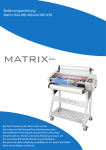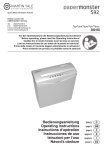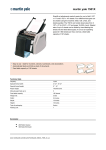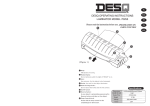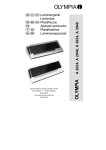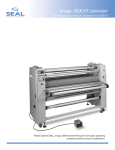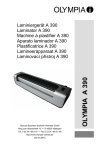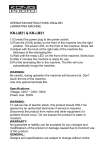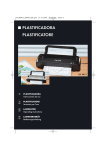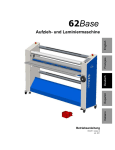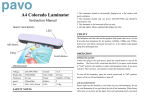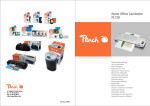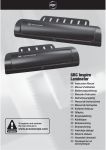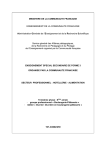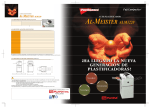Download Papermonster 12" Business Laminator - LA3
Transcript
Papermonster 12" Business Laminator - LA3 Instruction Manual Provided By http://www.MyBinding.com http://www.MyBindingBlog.com LA4 Postfach / p.o.box 1420 D-88672 Markdorf / Germany Tel.: +49(0)7544/60-0 Fax: +49(0)7544/60-248 E-mail: [email protected] Internet: www.martinyale.de Typ/Type/Type/Tipo/Típus: 397 Vor der Inbetriebnahme die Bedienungsanleitung durchlesen! Before operating, please read the Operating Instructions! Veuillez lire le mode d’emploi avant la mise en service! Leer las instrucciones de uso antes de la puesta en servicio! Prima della messa in funzione leggere attentamente le istruzioni! Před uvedením do provozu si přečtěte návod k obsluze! Bedienungsanleitung Operating instructions Instructions d’opération Instrucciones de uso Istruzioni per l’uso Návod k obsluze (Seite 2-3) D (page 4-5) GB (page 6-7) F (página 8-9) E (pagina 10-11) I (strana 12-13) CZ LAMINIERGERÄT D LA4 WICHTIGE SICHERHEITSHINWEISE « Zur Benutzung muss das Gerät standsicher (ebene Grundfläche) aufgestellt sein! « Verletzungsgefahr! Nicht mit den Fingern in die Einlassöffnung fassen! « Das Gerät darf nur außerhalb der Reichweite von Kindern aufgestellt werden! Sollte das Gerät in einem Umfeld von Kindern eingesetzt werden müssen, ist die Aufsicht durch einen befugten Erwachsenen notwendig. « Reparaturen dürfen nur von einem Fachmann durchgeführt werden! Zur Gewährleistung der Sicherheit dürfen nur Original-MartinYale-Ersatzteile verwendet werden. « Vor dem Öffnen des Gerätes ist der Netzstecker zu ziehen! FUNKTIONSELEMENTE 3 2 4 Legende 1 Laminiereinsatz 2 Ausgangsschacht 3 ABS-Schalter 4 OFF/AUS 5 HOT/HEISS 6 Anzeige 7 Schiebeschalter 8 COLD/KALT 5 8 1 6 7 Abb. 1 BEDIENUNGSANLEITUNG (A) HEISSLAMINIEREN Achtung! Laminator-Oberseite während des Betriebs nicht berühren. Die Geräteoberseite wird während des Betriebs sehr heiß und muss nach Gebrauch ca. 3 - 4 Stunden abkühlen. Achtung! In diesem Betriebsmodus keine wärmeempfindlichen Materialien, wie z.B. Thermofax-Papier laminieren. Diese Materialien sind nur für Kaltlaminierverfahren geeignet. 2. Schalter auf HOT (HEISS) stellen, um den Vorheizprozess zu starten. Die Anzeige leuchtet ROT auf. 3. Nach 3 - 5 Minuten Vorheizdauer leuchtet die Anzeige BLAU, d.h. dass der Laminator die richtige Betriebstemperatur erreicht hat und zum Laminieren bereit ist. 4. Laminierobjekt in die Laminiertasche einlegen, dabei in der Tasche an die bereits versiegelte Kante anlegen. Um das Objekt herum einen Rand von 3 - 5 mm freilassen. 6. Die Laminiertasche durchläuft den Laminator und wird an der Laminator-Rückseite wieder ausgegeben. 1. Netzteil des Laminators an eine Steckdose anschließen. 9. Netzteil des Laminators von der Steckdose trennen. (B) KALTLAMINIEREN WICHTIG Vor dem Kaltlaminieren muss der Laminator etwa 2 Stunden lang abkühlen, wenn er von Heiß- auf Kaltlaminieren umgestellt wird. Hinweis Die Laminiertaschen müssen eine Stärke von höchstens 250 Mikrometer (2 x 125 Mikrometer pro Seite) und mindestens 100 Mikrometer (2 x 50 Mikrometer pro Seite) aufweisen. 5. Die versiegelte Kante der Laminiertasche gerade in die Mitte der Laminator-Öffnung einschieben. Abb. 2 8. Schalter nach Gebrauch auf AUS (OFF) stellen. 7. Manche Papiersorten werden nicht gleichmäßig laminiert oder sehen trübe aus. In diesem Fall kann das Laminierobjekt erneut in den Laminator eingelegt werden, um den Laminierprozess zu wiederholen. 2 Abb. 3 1. Netzteil des Laminators an eine Steckdose anschließen. 2. Schalter auf COLD (KALT) stellen, um den Laminierprozess zu starten. Die Anzeige leuchtet ROT auf. 3. Kalt-Laminiertasche gerade in die Mitte der Laminator-Öffnung einschieben. Nur Laminiertaschen verwenden, die ausdrücklich für Kaltlaminierverfahren geeignet sind. LAMINIERGERÄT D WARTUNG BEDIENUNGSANLEITUNG 4. Die Laminiertasche durchläuft den Laminator und wird an der Laminator-Rückseite wieder ausgegeben. Laminiertasche entnehmen, wenn sie sich nicht mehr bewegt. 5. Schalter nach Gebrauch auf AUS (OFF) stellen. 6. Netzteil des Laminators von der Steckdose trennen. LA4 1. Gerät nach Gebrauch ausschalten und die kleinen Öffnungen nicht abdecken, damit die Hitze entweichen kann. 2. Auf dem Gerät keine schweren oder scharfen Materialien ablegen, um das Gerät nicht zu deformieren oder zu beschädigen. 3. Vor und nach dem Laminieren ein Blatt weißes Papier einlegen, um ggf. vorhandenen Staub von der Walze zu entfernen. 4. Geräteoberflächen nicht mit ätzenden Lösungsmitteln reinigen. Beim Reinigen des Geräts mit einem feuchten Tuch darauf achten, dass kein Wasser in das Gerät tropft, da ansonsten Störungen in der Elektronik entstehen können. 5. Wird das Gerät über einen längeren Zeitraum nicht benutzt, sollte es mit Plastikfolie oder einem Tuch abgedeckt werden, um es vor Staub zu schützen. FOLIENSTAU BEHEBEN Der Laminator ist mit einer Anti-Folienstaufunktion ausgerüstet, mit der sämtliche Folienstaus beim Laminieren behoben werden können. 1. Schalter auf OFF (AUS) stellen und den Laminator von der Stromversorgung trennen, sobald ein Stau auftritt. Laminator kurz abkühlen lassen. 2. Anti-Folienstauschalter (ABS) auf der Geräterückseite in Pfeilrichtung schieben und festhalten, anschließend die gestaute Folie vollständig aus der Laminator-Öffnung entfernen. 1 Abb. 4 Legende 1 ABS-Schalter STÖRUNGSBESEITIGUNG PROBLEM GRUND LÖSUNG 1. Die Geräteanzeige leuchtet blau, das lami- 1. Unsachgemäße Verwendung von Laminiernierte Material kommt nach dem Einlegen über folie, z.B.: ungleichmäßig laminierte Kanten der einen längeren Zeitraum nicht aus dem Ausga- Folie verunreinigen die Walze mit Klebstoff; zu beschacht und das Gerät verursacht Geräusche viel freier Bereich an der Folienvorderkante; die Stärke des laminierten Dokuments liegt über der sowie einen unangenehmen Geruch. max. Laminierstärke. Strom ausschalten und Gerät vom Netz trennen, gestaute Folie aus dem Einsatz entfernen; besteht das Problem weiterhin, bitte vom Fachmann warten lassen.. 2. Folienstau am Ausgangsschacht.. 2. Die Stromanzeige leuchtet nicht.. 1. Der Gerätestecker ist noch nicht eingesteckt. 2. Der Netzschalter ist noch nicht eingeschaltet. 3. Die elektrische Sicherung ist defekt.. Überprüfen, dass das Gerät mit der Stromversorgung verbunden ist, bzw. dass der Netzschalter eingeschaltet ist oder einen Wartungstechniker bitten, den Stromkreis zu prüfen; andernfalls das Gerät bitte ins Wartungszentrum einsenden.+ 3. Treten andere Probleme auf, Gerät abschalten und ins Wartungszentrum einsenden. ENTSORGUNG ENTSORGUNG DER MASCHINE: Entsorgen Sie die Maschine am Ende ihrer Lebensdauer stets umweltgerecht. Geben Sie keine Teile der Maschine oder der Verpackung in den Hausmüll. SONDERZUBEHÖR Benennung Best.-Nr. XXXXX xxxxx Hinweis: Bei Nachbestellung von Sonderzubehörteilen und bei Ersatzteilbedarf wenden Sie sich bitte an Ihren Fachhändler.. Stromverbrauch: Max. Laminierbreite: Max. Laminierstärke: Vorheizzeit: Betriebszeit: Laminiergeschwindigkeit: Nettogewicht: Abmessungen (L*B*H): 3 TECHNISCHE DATEN 220 V - 240 VAC, 50 Hz 230 mm (125 x 2) Mikrometer 3 - 5 Min. 30 Min. ein, 30 Min. aus 200 mm/Min. 0,95 kg 385 x 110 x 66 mm LAMINATOR GB LA4 IMPORTANT SAFETY NOTES « Mount the machine in a stable position for use (on a level surface). « Danger of injury! Never insert fingers into opening! « Repairs should only be carried out by a qualified specialist. To ensure safety, only original Martin Yale spare parts should be used. « Always ensure the machine is mounted out of the reach of children. If the cutter is to be used by children in certain circumstances, they must be supervised by a responsible adult. « Always unplug the machine from the mains power supply before opening the machine! FUNCTIONAL ELEMENTS 3 2 4 Legend 1 Laminating insert 2 Rear exit 3 ABS Switch 4 OFF 5 HOT 6 Indicator 7 Slide switch 8 COLD 5 8 1 6 7 Figure 1 OPERATION GUIDE (A) HOT LAMINATING Warning Do not touch the top of the laminator during use. The top of the laminator gets very hot during use and takes approx. 3–4 hours to cool down after use. Warning Do not laminate any heat-sensitive material e.g. thermo-fax paper in this mode. These materials are only suitable for cold laminating. 2. Slide the switch to HOT to start the heating process. The indicator will light up in RED. 3. After 3–5 minutes heating process, the indicator will light up in BLUE, meaning the laminator has reached the correct operating temperature and is ready to laminate. 4. Place the item to be laminated into the laminating pouch, centring it within the pouch alongside the pre-sealed edge. Leave a margin of 3–5 mm all round the item. Note Do not use pouches thicker than 250 micron (2 x 125 micron per side) or less than 100 micron (2 x 50 micron per side). 8. Slide the switch to OFF after use. 9. Disconnect the laminator from the power supply outlet. (B) COLD LAMINATING IMPORTANT Cold laminating requires the laminator to be cooled down for about 2 hours when it is switched from hot to cold laminating 1. Connect the laminator to the power supply outlet. 5. Insert the sealed edge of the laminating pouch straightly into the centre of the laminator opening. 6. The laminating pouch will pass through the laminator and exit at the rear of the laminator. Figure 2 1. Connect the laminator to the power supply outlet. 7. Some sorts of paper do not laminate evenly, or appear somewhat cloudy. In such cases the lamination can be fed through the laminator a second time and the lamination process repeated. 4 Figure 3 2. Slide the switch to COLD to start the lamination process. the indicator light will light up in RED. 3. Insert the could laminating pouches straightly into the centre of the laminator opening. Only use laminating pouches that are expressly suitable for cold laminating. LAMINATOR GB LA4 OPERATION GUIDE 4. The laminating pouch will pass through the laminator and exit at the rear of the laminator. Remove the laminating pouch when it has stopped moving. 5. Slide the switch to OFF after use. 6. Disconnect the laminator from the power supply outlet. MAINTENANCE 1. After using the machine, pls plug off the machine and pls don‘t cover up the small holes so as to let out the heat. 2. Don‘t place heavy ore sharp materials onto the machine in order not to distort or damage the machine. 3. Before and after laminating, you may insert 1 pc of white paper so as to take out the possible dust in the roller. 4. Don‘t clean the surface of the machine with corrosive solvent. Don‘t drop any water inside the machine when cleaning the machine with a wet cloth, otherwise, it may led to problems in PCB. 5. If the machine is unused for a long time, pls cover up the machine with a plastic or cloth to get rid of the dust. CLEARING A BLOCKAGE This laminator is equipped with an anti-blockage function to resolve any blockage of the laminating items during laminating. 1. Slide the switch to OFF and disconnect the laminator from the power supply outlet immediately when its jammed. Cool the laminator down briefly. 2. Slide and hold the anti-blockage switch (ABS) on the back of the laminator as in the direction indicated by the arrow sign, and pull the jammed item completely out from the laminator opening. 1 Figure 4 Legend 1 ABS Switch BRIEF PROBLEM SHOOTING PROBLEMS 1. When the Machine is in blue indicator, the laminating material doesn‘t come out from the exit after inserting for a long time, and there is noise as well as bad smell coming from the machine. REASONS SOLUTIONS 1. Improper use of laminating film, such as: une- Please switch off the power and unplug the maven laminates edges on the film which makes the chine, pull out the jammed films from the insert; roller stuck with glue; you reserve too much area if there is still any problem, please turn to profesin the front of the film; the laminated thickness sional for maintenance. has exceeded the max. laminating thickness. 2. There is a barrier at the rear exit. 2. The power indicator is not on. 1. The machine is not yet plug in; 2. The power switch is not switched on; 3. The electric current fuse has been destroyed. Pls check and make sure if the machine is plug in or not and if the power switch is switched on or not, or pls ask the maintenance personnel to check the circuit; otherwise, pls send the machine to maintenance centre. 3. If other problems happen, pls plug off the machine and send it to maintenance centre. MALFUNCTION DISPOSING OF THE MACHINE: Dispose of the machine in an environmentally sound fashion at the end of its usefull service life. Do not dispose of any of the parts included in the machine or its packing with household trash. SPECIAL ACCESSOIRES Description XXXXX Note: For orders of special accessoires and spare parts, please contact your dealer. TECHNICAL DATA Power consumption: Max. laminating width: Max. laminating thickness: Preheating time: Working time: Laminating speed: Net Weight: Dimensions (L*W*H): 5 220 V - 240 VAC, 50 Hz 1.1A 230 mm (125 x 2) mic 3–5 min. 30 min. on, 30 min. off 200 mm/min. 0.95 kg 385 x 110 x 66 mm Order-No. xxxxx APPAREIL DE LAMINAGE F LA4 RECOMMANDATIONS IMPORTANTES DE SÉCURITÉ « La machine doit être installée en position stable (surface plane) avant l‘utilisation! « Risque de blessure! N’introduisez jamais les doigts dans l’ouverture! « La machine doit impérativement être installée hors de portée des enfants! Si la machine doit être utilisée dans une zone où séjournent des enfants, un adulte autorisé doit se charger de leur surveillance. « Les réparations ne doivent être effectuées que par un spécialiste! Afin de garantir la sécurité, seules des pièces de rechange d‘origine Martin Yale doivent être utilisées. « Débrancher le raccordement réseau avant d’ouvrir l’installation! ELEMENTS FONC TIONNELS 3 2 4 Légende 1 Fente 2 Sortie arrière 3 Interrupteur ABS 4 OFF 5 CHAUD 6 Voyant 7 Interrupteur à glissière 8 FROID 5 8 1 6 7 fig. 1 MODE D’EMPLOI (A) LAMINAGE A CHAUD Avertissement Ne jamais toucher le dessus de la lamineuse pendant son utilisation. La partie supérieure de la lamineuse est extrêmement chaude pendant son fonctionnement, son refroidissement dure environ 3 à 4 heures une fois la machine arrêtée. Avertissement Il est fortement prohibé de laminer du matériau sensible à la chaleur comme le papier thermique pour fax. Les matériaux non résistants à la chaleur ne peuvent être utilisés que pour le laminage à froid. 1. Branchez la lamineuse à une source de courant. 8. Poussez l’interrupteur vers OFF après l’utilisation de la lamineuse. 2. Poussez l’interrupteur à glissière sur CHAUD pour lancer le chauffage. Le voyant est alors au ROUGE. 9. Débranchez la lamineuse de l’alimentation en courant. 3. Au bout de 3 à 5 minutes de chauffage le voyant passe au BLEU. La lamineuse a atteint la bonne température et est prête à l’emploi. 4. Introduisez l’objet à laminer dans la poche de laminage, centrez-le à l’intérieur de la poche côté de la bordure pré-scellée. Prévoyez une marge de 3 à 5 mm à la périphérie de l’objet. IMPORTANT Le laminage à froid nécessite environ 2 heures de refroidissement de la lamineuse, lorsqu’elle doit passer du mode laminage à chaud au mode laminage à froid. Remarque Ne pas utiliser de poches plus épaisses que 250 microns (2 x 125 microns par côté) ou inférieures à 100 microns (2 x 50 microns par côté). 5. Insérez les bords scellés de la poche de laminage directement au centre de l’ouverture de la lamineuse. 6. La poche de laminage doit passer à travers la lamineuse et sortir à l’arrière. fig. 2 (B) LAMINAGE A FROID 7. Certains types de papier ne se laissent pas laminer sans se froisser ou présentent un aspect brumeux. Si tel est le cas, l’objet laminé peut être introduit une seconde fois dans la lamineuse et le laminage répété. 6 fig. 3 1. Branchez la lamineuse sur une source de courant. 2. Poussez l’interrupteur à glissière vers FROID de façon à lancer le laminage. Le voyant doit être alors sur ROUGE. 3. Introduisez les poches de laminage froides directement au centre de l’ouverture de la lamineuse. N’utilisez que des poches de laminage prévues pour le laminage à froid. APPAREIL DE LAMINAGE F MAINTENANCE MODE D’EMPLOI 4. La poche de laminage passe à travers la lamineuse et sort par l’arrière. Retirez la poche de laminage lorsqu’ elle a cessé d’avancer. 5. Poussez l’interrupteur vers OFF, après utilisation de la lamineuse. 6. Débranchez la lamineuse de l’alimentation en courant. LA4 1. Après utilisation de l’appareil, débranchez-le et n’obstruez pas les petits trous, de sorte que la chaleur puisse en sortir. 2. Ne pas poser d’objets lourds ou coupants sur l’appareil afin d’éviter toute distorsion ou tout dommage de celui-ci. 3. Avant et après le laminage, insérez une feuille de papier blanc de façon à extraire les poussières risquant de polluer les rouleaux de la lamineuse. 4. Lorsque vous nettoyez la surface de l’appareil, utilisez des produits de nettoyage non corrosifs. Evitez que des gouttes d’eau ne pénètrent dans l’appareil, l’eau infiltrée risquant d’endommager les plaquettes du circuit imprimé. 5. Si l’appareil n’est pas utilisé sur une période prolongée, protégez-le en le recouvrant d’une housse plastique ou d’une couverture pour empêcher la poussière de s’y déposer. ELIMINER UN BLOCAGE La présente lamineuse est dotée d’une fonction antiblocage permettant d’éliminer tout blocage d’objet en cours de laminage. 1. Poussez l’interrupteur sur OFF et débranchez la lamineuse de sa source d’alimentation en courant dès qu’un blocage survient. Patientez jusqu’à refroidissement de la lamineuse. 2. Poussez et maintenez l’interrupteur antiblocage (interrupteur ABS) situé sur la partie arrière de la lamineuse en direction des flèches, de façon à pouvoir retirer l’objet bloqué de l’ouverture de la lamineuse. 1 fig. 4 Légende 1 Interrupteur ABS APERCU DES PANNES POSSIBLES PROBLEMES CAUSES SOLUTIONS 1. Le voyant de l’appareil est au bleu et le maté- 1. Mauvaise utilisation du film de laminage : le riel à laminer introduit ne ressort pas après un film bloque les rouleaux avec la colle, les bords temps, l’appareil émet des bruits étranges et une et coins n’ayant pas été aplanis correctement. mauvaise odeur s’en échappe. Trop de marge sur l’avant du film. L’épaisseur maximale de laminage est atteinte. Arrêtez et débranchez l’appareil, de sorte à pouvoir ensuite retirer avec précaution le film resté coincé dans la lamineuse. Si le problème persiste, veuillez vous adresser à un professionnel. 2. Quelque chose obstrue la sortie arrière. 2. Le voyant Power n’est pas allumé. 11. L’appareil n’a pas été branché. 2. L’interrupteur Power n’a pas été activé. 3. Le fusible a sauté. Vérifiez si l’appareil a été branché correctement et si l’interrupteur Power a été activé ou non. Sinon, adressez-vous à un professionnel, qu’il puisse vérifier si le circuit est encore en état de fonction ou renvoyez l’appareil à notre SAV. 3. Si d’autres problèmes surviennent, débranchez l’appareil et retournez-le au SAV le plus proche. ELIMINATION ELIMINATION DE LA MACHINE: En fin de vie, éliminez toujours la machine de façon conforme à l‘environnement. Ne jetez aucun composant de la machine ou de son emballage dans les ordures ménagères. ACCESSOIRES Designation XXXXX Notez: Pour les accessoires et pièces détachées, veuillez contacter votre agent. CARACTÉRISTIQUES TECHNIQUES Alimentation : Largeur max. de laminage : Epaisseur max. de laminage : Temps de préchauffage : Temps de fonctionnement : Vitesse de laminage : Poids net : Dimensions (L, l, h) : 7 220 V - 240 VAC, 50 Hz 230 mm (125 x 2) microns 3 - 5 min. 30 min. en marche, 30 min. d’arrêt 200 mm/min. 0,95 kg 385 x 110 x 66 mm Ordre-No. xxxxx LAMINADORA E LA4 INDICACIONES DE SEGURIDAD IMPORTANTES « ¡El aparato se tiene que colocar sobre una superficie estable (superficie base plana) para el uso! « ¡Peligro de lesión! No introducir los dedos en la apertura de alimentación! « ¡El aparato sólo se debe instalar en un lugar fuera del alcance de los niños! Cuando la Cortadora vaya a ser instalada en una estancia frecuentada por niños, se deberá prever obligatoriamente una supervisión por un adulto autorizado. « ¡Las reparaciones solamente deben ser llevadas a cabo por un técnico cualificado! Con el fin de garantizar una seguridad plena, solamente deberán emplearse piezas de repuesto originales de MartinYale. « Antes de abrir el aparato hay que extraer la clavija de red! ELEMENTOS FUNCIONALES 3 2 4 Leyenda 1 Inserción de plastificado 2 Salida posterior 3 Interruptor antibloqueo (ABS) 4 Apagado/OFF 5 CALIENTE 6 Indicador piloto 7 Interruptor corredizo 8 FRÍO 5 8 1 6 7 Fig. 1 INSTRUCCIONES DE EMPLEO (A) PLASTIFICADO EN CALIENTE ¡AVISO! No toque la parte superior de la plastificadora durante el empleo. La parte superior de la plastificadora se calienta mucho durante el uso y tarda aprox. 3 a 4 horas para enfriarse tras el uso. ¡AVISO! No plastifique de este modo materiales sensibles al calor, p. ej. papel termofax. Estos materiales solo se pueden plastificar en frío. 3. Después de 3 a 5 minutos de proceso de calentamiento, el indicador piloto se conmutará a color AZUL, lo que significa que la plastificadora ha alcanzado la temperatura correcta de operación y está lista para el plastificado. 4. Coloque el artículo para ser plastificado dentro de la funda de plastificado, céntrelo dentro de la funda a lo largo del borde presellado. Deje un margen de 3 a 5 mm alrededor del artículo. Nota No utilice fundas de un espesor superior a 250 micrones (2 x 125 micrones por lado) o bien de menos de 100 micrones (2 x 50 micrones por lado). 9. Desconecte la plastificadora del enchufe de abastecimiento de corriente. (B) PLASTIFICADO EN FRÍO IMPORTANTE El plastificado en frío requiere que la plastificadora se haya enfriado durante unas 2 horas al conmutarla de plastificado en caliente a en frío. 1. Conecte la plastificadora al enchufe de abastecimiento de corriente. 5. Inserte el borde sellado de la funda de plastificado en posición recta en el centro de la apertura de la plastificadora. 6. La funda de plastificado pasará a través de la plastificadora y saldrá en la parte posterior de la plastificadora. Fig. 2 1. Conecte la plastificadora al enchufe de abastecimiento de corriente. 2. Deslice el interruptor a CALIENTE para iniciar el proceso de calentamiento. El indicador piloto se encenderá en VERDE. 7. Algunas clases de papel no se plastifican planas, o aparecen algo opacas. En tales casos, el plastificado puede hacerse avanzar a través de la plastificadora una segunda vez y repetir el proceso de plastificado. 8. Deslice el interruptor a la posición OFF de apagado después del uso. 8 Fig. 3 2. Deslice el interruptor a la posición FRÍO para iniciar el proceso de plastificado en frío, el indicador piloto se encenderá en color VERDE. 3. Inserte las fundas de plastificado en frío en posición recta en el centro de la apertura de la plastificadora. Utilice solo fundas de plastificado que sean aptas expresamente para el plastificado en frío. LAMINADORA E MANTENIMIENTO INSTRUCCIONES DE EMPLEO 4. La funda de plastificado pasará a través de la plastificadora y saldrá en la parte posterior de la plastificadora. Retire la funda de plastificado cuando haya cesado de moverse. 5. Deslice el interruptor a la posición OFF de apagado después del uso. 6. Desconecte la plastificadora del enchufe de abastecimiento de corriente. LA4 4. No limpie la superficie del equipo con un disolvente corrosivo. No deje que se infiltre agua dentro del equipo al limpiar el mismo con un paño húmedo, porque sino se podrían causar problemas en el tablero de circuitos impresos. 1. Después de usar el equipo, desenchufe el mismo y no cubra los pequeños orificios para que pueda disiparse el calor. 2. No coloque materiales pesados o puntiagudos sobre el equipo a fin de no deteriorar o dañar el equipo. 5. Si el equipo no se va a utilizar por un periodo prolongado de tiempo, cubra el equipo con un plástico o paño para mantenerlo libre de polvo. 3. Antes y después del proceso de plastificado, se deberá insertar 1 pieza de papel blanco de tal modo que se pueda recoger la mayor cantidad de polvo posible en el rodillo. ELIMINACIÓN DE UN BLOQUEO Esta plastificadora está equipada con una función antibloqueo para eliminar todo tipo de bloqueos de los artículos plastificados durante el proceso de plastificado. 1. Deslice el interruptor a la posición OFF de apagado y desconecte la plastificadora empleando el enchufe de abastecimiento de corriente, y hágalo de inmediato al producirse un atasco. Deje enfriar brevemente la plastificadora. 2. Deslice y sujete el interruptor antibloqueo (ABS) en la parte posterior de la plastificadora como en la dirección indicada por el signo de flecha, y empuje el artículo atascado completamente hacia fuera de la apertura de la plastificadora. 1 Fig. 4 Leyenda 1 Interruptor antibloqueo ABS BREVE RELACIÓN DE LA ELIMINACIÓN DE ERRORES PROBLEMAS CAUSAS SOLUCIONES 1. El equipo está en indicador piloto azul, el material plastificado no sale desde la salida posterior después de insertarlo por un periodo prolongado de tiempo, y se produce un ruido así como un olor desagradable que procede del equipo.. 1. Utilización inapropiada de la película de plastificado, como por ejemplo: bordes de plastificado desnivelados sobre la película que conllevan que el rodillo se haya quedado enganchado con adhesivo; se ha reservado demasiado espacio en la parte frontal de la película; el espesor de plastificado ha excedido el espesor máx. de plastificado. Desconecte el interruptor y desenchufe el equipo, saque las películas dañadas desde la inserción; si no se elimina el problema de esta manera, acuda al especialista para que realice el mantenimiento. 2. El piloto de corriente no está encendido. 1. El equipo aún no se ha enchufado; 2. Hay una barrera en la salida posterior. 2. El interruptor de corriente no se ha conectado; 3. El fusible de corriente eléctrica se ha destruido. Compruebe y cerciórese de que el equipo está enchufado y el interruptor está conectado, o consulte al personal técnico de mantenimiento para verificar el circuito; en otro caso; envíe el equipo al centro de mantenimiento. 3. Si surgieran otros problemas, desenchufe el equipo y mande el equipo al centro de mantenimiento. ELIMINACIÓN ELIMINACIÓN DE LOS RESIDUOS DE LA MÁQUINA: Elimine los residuos de la máquina al final de su vida útil respetando siempre las normas medioambientales. No tire partes de la máquina ni el embalaje junto con la basura doméstica. ACCESSORIO ESPECIAL Denominación N° de pedido XXXXX xxxxx Inicación: En el caso de pedidos ulteriores de accesorios especiales y de piezas de repuesto, rogamos se dirija a nuestro representante oficial. CARACTERISTICAS TECNICAS Consumo de corriente: Anchura máx. de plastificado: Espesor máx. de plastificado: Duración de precalentamiento: Duración de servicio: Velocidad de plastificado: Peso neto: Dimensiones (Lon*An*Al): 9 220 V - 240 VAC, 50 Hz 230 mm (125 x 2) mic de 3 a 5 min 30 min. encendido, 30 min. apagado 200 mm / min 0,95 kg 385 x 110 x 66 mm PLASTIFICATORE I LA4 IMPORTANTI ISTRUZIONI DI SICUREZZA « Per poter essere impiegata, l‘apparecchio deve essere sistemata su appoggio sicuro (superficie di base piana)! « Pericolo di lesioni! Non avvicinarsi con le dita alla bocca d‘immissione! « L‘apparecchio deve essere sistemata sempre fuori dalla portata di bambini! Nel caso che la taglierina debba essere impiegata in ambiente dove si trovino bambini, è necessario che venga sorvegliata da parte di un adulto autorizzato. « La riparazioni devono essere eseguite solo da parte di uno specialista! Perché possa essere garantita la sicurezza devono essere utilizzati solamente ricambi originali MartinYale. « Innanzi l‘apertura della macchina staccare la spina! ELEMENTI FUNZIONALI 3 2 4 Legenda 1 Inserto di laminazione 2 Porta di uscita posteriore 3 Interruttore anti-inceppamento 4 OFF 5 HOT (caldo) 6 Indicatore 7 Commutatore a slitta 8 COLD (freddo) 5 8 1 6 7 Fig. 1 GUIDA ALL‘USO (A) LAMINAZIONE A CALDO Attenzione Non toccare la parte superiore del laminatoio durante l‘uso. Quest‘area, infatti, diventa molto calda durante il funzionamento e necessita di circa 3 - 4 ore per raffreddarsi dopo l‘uso. 2. Portare il commutatore nella posizione HOT (caldo) per avviare il processo di riscaldamento. L’indicatore si accende con luce ROSSA. 3. Dopo 3 - 5 minuti di riscaldamento, l‘indicatore diventa di colore BLU; ciò significa che il laminatoio ha raggiunto la propria regolare temperatura d‘esercizio ed è pronto per la laminazione. Attenzione Non utilizzare la laminazione a caldo per materiali sensibili al calore, ad esempio la carta termica per fax. 4. Inserire l‘oggetto da laminare nella sacca di laminazione, centrandolo nella sacca rispetto al bordo pre-sigillato. Lasciare un margine di 3 - 5 mm tutto intorno all‘oggetto. Questi materiali possono essere laminati soltanto a freddo. Nota Non utilizzare tasche di spessore superiore a 250 micron (2 x 125 micron per lato) o inferiore a 100 micron (2 x 50 micron per lato). 8. Dopo l‘uso, portare il commutatore nella posizione OFF. 9. Scollegare il laminatoio dalla presa di corrente. (B) LAMINAZIONE A FREDDO IMPORTANTE Per eseguire la laminazione a freddo è necessario lasciar raffreddare il laminatoio per 2 ore dopo la commutazione dal processo a caldo a quello a freddo. 1. Collegare il laminatoio alla presa di corrente. 5. Inserire il bordo pre-sigillato della sacca di laminazione al centro dell’apertura del laminatoio, mantenendolo dritto. 6. La sacca di laminazione attraverserà il laminatoio e uscirà dalla porta posteriore del laminatoio. Fig. 2 1. Collegare il laminatoio alla presa di corrente. 7. Alcuni tipi di cara non vengono laminati in maniera uniforme, o presentano degli offuscamenti. In tali casi l‘oggetto laminato può essere inserito nuovamente nel laminatoio e sottoposto a un secondo processo di laminazione. 10 Fig. 3 2. Portare il commutatore nella posizione COLD (freddo) per avviare il processo di laminazione. L‘indicatore si accende con luce ROSSA. 3. Inserire le sacche di laminazione a freddo nel centro dell‘apertura del laminatoio, mantenendole dritte. Utilizzare soltanto sacche di laminazione espressamente intese per la laminazione a freddo. PLASTIFICATORE I LA4 MANUTENZIONE GUIDA ALL‘USO 4. La sacca di laminazione attraverserà il laminatoio e uscirà dalla porta posteriore del laminatoio. Attendere che la sacca di laminazione si arresti prima di prelevarla. 5. Dopo l‘uso, portare il commutatore nella posizione OFF. 6. Scollegare il laminatoio dalla presa di corrente. 1. Dopo aver utilizzato la macchina, staccare la spina elettrica e non coprire i fori per permettere la fuoriuscita del calore. 2. Non appoggiare oggetti pesanti o affilati sulla macchina per evitare deformazioni e danni alla macchina stessa. 3. Prima e dopo la laminazione è vantaggioso rimuovere eventuali tracce di polvere presenti sul rullo, inserendo 1 foglio di carta bianco nella macchina. 4. Non pulire la superficie della macchina con solventi corrosivi. Se si pulisce la macchina con un panno bagnato, prestare la massima attenzione a non far entrare la benché minima quantità d‘acqua all‘interno della macchina stessa; in caso contrario potranno verificarsi problemi al circuito stampato. 5. Se la macchina non deve essere utilizzata per lungo tempo, coprirla con un telo di plastica o di stoffa per evitare l‘accumulo di polvere. COME COMPORTARSI IN CASO DI INCEPPAMENTO Il laminatoio è dotato di una funzione anti-inceppamento per far fronte a eventuali inceppamenti degli oggetti di laminazione durante il processo. 1. Non appena si verifica il problema, portare il commutatore in posizione OFF e scollegare il laminatoio dalla presa di corrente. Lasciare raffreddare brevemente il laminatoio. 2. Spostare l‘interruttore anti-inceppamento, disposto sul retro del laminatoio, nella direzione indicata dalla freccia e mantenerlo in tale posizione; allo stesso tempo estrarre completamente l‘oggetto incastrato dall‘apertura del laminatoio. 1 Legenda 1 Interruttore anti-inceppamento Fig. 4 BREVE GUIDA ALLA RISOLUZIONE DEI PROBLEMI PROBLEMA CAUSA SOLUZIONE 1. L‘indicatore della macchina è acceso con luce blu; il materiale di laminazione è dentro la macchina da diverso tempo e non viene erogato dalla porta di uscita; inoltre dalla macchina provengono rumori e odori molesti. 1. Uso improprio della pellicola di laminazione, ad esempio: bordi di laminazione non uniformi sulla pellicola con conseguente attaccatura di colla sul rullo; troppo spazio libero lasciato davanti alla pellicola; spessore di laminazione superiore a quello massimo consentito. Staccare l‘alimentazione elettrica e isolare la macchina, estrarre le pellicole incastrate dall‘inserto. Se i problemi permangono rivolgersi a un esperto per la manutenzione.. 2. Presenza di un ostacolo davanti alla porta di uscita posteriore. 2. L‘indicatore di alimentazione non è acceso. 1. La macchina non è ancora stata collegata alla Verificare e assicurarsi che la macchina sia collegata alla rete elettrica e che il commutatore di rete elettrica. accensione sia inserito; in alternativa, richiedere 2. Il commutatore di accensione è disinserito. al personale di manutenzione di verificare le condizioni del circuito; in alternativa, inviare la 3. Il fusibile elettrico è danneggiato. macchina al centro manutenzione. 3. Se si verificano altri problemi, staccare la macchina dalla rete elettrica e inviarla al centro di manutenzione. SMALTIMENTO ACCESSORI SPECIALI SMALTIMENTO DELLA MACCHINA: Smaltire la macchina nel rispetto dell’ambiente al termine della durata d‘utilizzo. Non gettare parti della macchina o dell’imballaggio nei rifiuti domestici. Denominazione N. di matricola. XXXXX xxxxx Nota: Per le ordinazioni di pezzi accessori speciali si prega di rivolgersi al proprio rivenditore specializzato. DATI TECNICI Potenza assorbita: Larghezza di laminazione max.: Spessore di laminazione max.: Durata del pre-riscaldamento: Durata della lavorazione: Velocità di laminazione: Peso netto: Dimensioni (L*W*H): 11 220 V - 240 VAC, 50 Hz 230 mm (125 x 2) mic 3–5 min. 30 min. acceso, 30 min. spento 200 mm/min. 0,95 kg 385 x 110 x 66 mm LAMINOVACÍ CZ LA4 DŮLEŽITÁ BEZPEČNOSTNÍ UPOZORNĚNÍ « Pro používání se řezačka musí postavit na naprosto stabilní podklad (na rovnou plochu)! « Nebezpečí poranění! Nestrkejte prsty do přívodního otvoru! « Řezačka smí stát jen na místech mimo dosah dětí! Je-li nutné používat řezačku v přítomnosti a dosahu dětí, je nezbytné zajistit dozor dospělé osoby. « Opravy smí provádět jen odborník! K zajištění bezpečnosti se směji používat jen originální náhradní díly firmy Martin Yale. « Před otevřením stroje vytáhněte síťovou zástrčku! FUNKČNÍ PRVKY 3 2 4 Legenda 1 Laminovací otvor 2 Zadní výstup 3 ABS spínač 4 VYP 5 HORKÁ LAMINACE 6 Kontrolka 7 Posuvný spínač 8 STUDENÁ LAMINACE 5 8 1 6 7 Obr.1 NÁVOD K PROVOZU (A) HORKÁ LAMINACE Varování Nedotýkejte se horní části laminátoru při jeho používání. Horní část laminátoru se při používání velmi rychle zahřeje na vysokou teplotu a její ochlazení po použití trvá přibližně 3–4 hodiny. Varování V tomto režimu nelaminujte žádný materiál citlivý na teplo, např. faxový termopapír. Tyto materiály jsou vhodné pouze 1. Zapojte laminátor do elektrické zásuvky. 2. Pro spuštění procesu ohřevu nastavte spínač do polohy HORKÁ LAMINACE. Kontrolka začne svítit ČERVENĚ. 3. Po 3–5 minutách procesu ohřevu se kontrolka rozsvítí MODŘE, což znamená, že laminátor dosáhl správné provozní teploty a je připraven k laminaci. 4. Vložte dokument určený k zalaminování do laminovací kapsy, zarovnejte ho v kapse podél předem zataveného okraje. Kolem celého dokumentu ponechejte okraj 3-5 mm. 6. Laminovací kapsa projde laminátorem a vystoupí na zadní straně laminátoru. pro studenou laminaci. 9. Laminátor vypojte z elektrické zásuvky. (B) STUDENÁ LAMINACE DŮLEŽITÉ Studená laminace vyžaduje, aby se laminátor ochlazoval alespoň 2 hodiny po té, co byl přepnut z režimu horké laminace do režimu studené laminace. 1. Zapojte laminátor do elektrické zásuvky. Poznámka Nepoužívejte kapsy s tloušťkou větší než 250 mikronů (2 x 125 mikronů na jedné straně) nebo menší než 100 mikronů (2 x 50 mikronů na jedné straně). 5. Vložte zatavený okraj laminovací kapsy rovně doprostřed laminovacího otvoru. Obr. 2 8. Po použití nastavte spínač do polohy VYP. 7. Některé druhy papíru se nelaminují rovnoměrně nebo se jeví poněkud matně. V takovýchto případech lze dokument vložit do laminátoru podruhé a proces laminace zopakovat. 12 Obr. 3 2. Pro spuštění procesu laminace nastavte spínač do polohy STUDENÁ LAMINACE. Kontrolka začne svítit ČERVENĚ. 3. Kapsy pro studenou laminaci vkládejte rovně doprostřed laminovacího otvoru. Používejte pouze takové laminovací kapsy, které jsou výslovně určeny pro studenou laminaci. LAMINOVACÍ CZ LA4 ÚDRŽBA NÁVOD K PROVOZU 4. Laminovací kapsa projde laminátorem a vystoupí na zadní straně laminátoru. Až se laminovací kapsa přestane pohybovat, vyjměte ji. 5. Po použití nastavte spínač do polohy VYP. 6. Laminátor vypojte z elektrické zásuvky. 1. Po použití přístroje ho, prosím, odpojte od zdroje energie a nezakrývejte malé otvory, které odvádí teplo. 2. Nepokládejte na přístroj těžké nebo ostré materiály, jinak dojde k jeho deformaci nebo poškození. 3. Před a po laminování můžete vložit 1 kus bílého papíru, čímž odstraníte případný prach na válci. 4. Nečistěte povrch přístroje agresivním rozpouštědlem. Dovnitř přístroje se nesmí dostat ani kapka vody, jestliže ho čistíte mokrým hadříkem, jinak může dojít k problémům s deskou plošných spojů. 5. Jestliže přístroj nebudete používat delší dobu, zakryjte ho, prosím, plastem nebo látkou, abyste se zbavili prachu. ODSTRANĚNÍ UCPÁNÍ Laminátor je vybaven funkcí odstranění ucpání, která zlikviduje jakékoliv ucpání způsobené laminovanými dokumenty během laminace. 1. Jestliže došlo k ucpání, okamžitě nastavte spínač do polohy VYP a laminátor vypojte z elektrické zásuvky. Nechejte laminátor krátce vychladnout. 1 2. Posuňte a držte spínač pro odstranění ucpání (ABS) na zadní straně laminátoru ve směru znázorněné šipky a vytáhněte zaseknutý dokument zcela z otvoru laminátoru. Obr. 4 Legenda 1 ABS spínač RYCHLÉ ŘEŠENÍ PROBLÉMŮ PROBLÉMY PŘÍČINY ŘEŠENÍ 1. Jestliže kontrolka přístroje svítí modře, jestliže laminovaný materiál dlouho nevystupuje ven po jeho vložení a jestliže je z přístroje slyšet hluk a také cítit zápach.. 1. Nesprávné použití laminovací fólie, jako například: nestejné laminovací okraje na fólii, které způsobují zaseknutí válce v důsledku lepidla; ponecháváte příliš mnoho místa na začátku fólie; tloušťka laminace překročila max. tloušťku laminace. Vypněte, prosím, zařízení a odpojte ho od přívodu energie, vytáhněte zaseknuté fólie z laminovacího otvoru; pokud problém přetrvává, obraťte se na profesionály s žádostí o údržbu.. 2. V zadním výstupu se nachází překážka. 2. Kontrolka přívodu energie nesvítí. 1. Přístroj ještě není zapojen do zásuvky; 2. Přístroj není zapnutý na hlavním spínači; 3. Elektrická pojistka se přepálila. Prosím, zkontrolujte a ujistěte se, zda je přístroj zapojen do zásuvky a zda je zapnutý hlavní spínač, nebo požádejte personál údržby o kontrolu el. obvodu; jinak pošlete přístroj do střediska údržby. 3. Jestliže se objeví jiné problémy, odpojte, prosím, zařízení od zdroje energie a pošlete nám ho do střediska údržby. LIKVIDACE LIKVIDACE STROJE: Stroj na konci jeho životnosti likvidujte vždy s ohledem na životní prostředí. Žádné díly stroje nebo obalu nedávejte do domácího odpadu. ZVLÁŠTNÍ PŘÍSLUŠENSTVÍ Název Obj. čís. XXXXX xxxxx Upozornění: Při dodatečném objednání dílů zvláštního příslušenství a potřebě náhradních dílů se prosím obraťte na Vašeho odborného prodejce. TECHNICKÉ ÚDAJE Spotřeba energie: Max. šířka laminace: Max. tloušťka laminace: Doba nahřívání: Provozní doba: Rychlost laminace: Hmotnost netto: Rozměry (D*Š*V): 13 220 V - 240 VAC, 50 Hz 1.1A 230 mm (125 x 2) mikronů 3 - 5 min. 30 min. zap., 30 min. vyp. 200 mm/min. 0,95 kg 385 x 110 x 66 mm LA4 14 LA4 Konformitätserklärung Certificate of Conformity Attestation de Conformité Certificado de Conformidad Bezeichnung der Maschine: Type of machine: Description de la machine: Descripcion de la máquina: Laminiergerät Modell / Model / Modèle / Modelo: papermonster LA4 Typ / Type / Type / Tipo: 397 Laminator Appareil de laminage Laminadora Hiermit wird bestätigt, daß o. g. Gerät den Anforderungen der Niederspannungs-Richtlinie 2006/95/EG, sowie der EMV-Richtlinie 2004/108/EG einschließlich allen bis heute veröffentlichten Änderungen bzw. Nachträgen entspricht. Das o. g. Gerät entspricht folgenden Normen bzw. Richtlinien: We do hereby certify that the above mentioned product meets the requirements set forth in EEC-Low-Voltage-Directive 2006/95 and EMC directive 2004/108/EC including all changes and addendums to date thereto. The above mentioned product meets the following standards and guidelines: Nous Vous Confirmons que l‘appareils cité ci-dessus correspond aux des directives de basse tension 2006/95/CEE ainsi qu’ à la directive CEM 2004/108/CEE, ci-inclus toutes les modifications ainsi que tous les suppléments publiés jusqu’à ce jour. L‘appareil mentionné correspond aux normes citées ci-après: Confirmamos que los productos arriba citados cumplen las exigencias de las directivas de baja tensión 2006/95/CEE y las directivas CEM 2004/108/CEE, incluidas todas las modificaciones publicadas hasta la fecha. Los productos citados corresponden con las siguientes normas: EN 60950-1: 2001+A11 EG-Richtinie / EG-Guidelines / EG-Directives / EG-directivas, 87/308/EG EN 61000-3-2: 2006 EN 61000-3-3: 1995+A1+A2 EN 55014-1: 2000+A1+A2 EN 55014-2: 1997+A1 2009/08 ppa. K. Grundmann Leiter Technik Head of Technical Dpt. Responsable Dép. Technique Jefe del Departamento Técnico Postfach / p.o.box 1420 D-88672 Markdorf / Germany 15 i. V. W. Madena Leiter Elektrik Head of Electrical Dpt. Responsable Dép. Electricité Jefe del Departamento Eléctrico International Network Headquarters USA MARTIN YALE GROUP 251 Wedcor Avenue Wabash, IN 46992 www.martinyale.com ☏ +1 / 260 563-0641 fax +1 / 260 563-4575 [email protected] Germany MARTIN YALE INTERNATIONAL GmbH Bergheimer Straße 6-12 88677 Markdorf / Bodensee www.martinyale.de, www.intimus.com ☏ +49 / (0) 7544 60-0 fax +49 / (0) 7544 60-248 [email protected] South Africa MARTIN YALE Africa S & B House, 7 Loveday Street Marshall Town, Johannesburg P. O. BOX 1291, Houghton 2041 www.martinyale.co.za ☏ +27 / (0) 11 838 72 81 fax +27 / (0) 11 838 73 22 [email protected] United Kingdom MARTIN YALE International Unit C 2 The Fleming Centre, Fleming Way Crawley, West Sussex, RH10 9NN www.intimus.co.uk ☏ +44 / (0) 1293 44 1900 fax +44 / (0) 1293 61 11 55 [email protected] France MARTIN YALE International S.A.R.L. 40 Avenue Lingenfeld 77200 Torcy www.martinyale.fr ☏ +33 / (1) 70 00 69 00 fax +33 / (1) 70 00 69 24 [email protected] Spain MARTIN YALE Ibérica S.L. C/Maestrat, n° 26 Pol. Indus. Les Salines 08880 Cubelles (Barcelona) www.martinyale.es ☏ +34 / 9 02 22 31 31 fax +34 / 9 02 22 31 32 [email protected] Italy Martin Yale Italia srl Via A. Manzoni, 37 20052 Monza (MI) www.martinyale.it ☏ +39 / 335 618 4924 fax +39 / 039 689 3124 [email protected] Sweden MARTIN YALE Nordic Rotebergsvägen 1 S-192 78 Sollentuna www.martinyale.se ☏ +46 / 8 556 165 20 fax +46 / 8 748 02 85 [email protected] P.R. China MARTIN YALE Beijing Room 2003 D Building Guojiang No 2 Dong Sanhuan Bei Lu Chaoyang District, Beijing 100027 www.martinyale.com.cn ☏ +86 / (0) 10 84 47 10 70 fax +86 / (0) 10 84 47 10 75 [email protected] Dieses Papier ist aus 100 % Altpapier ohne optische Aufheller hergestellt This paper made from 100 % unbleached recycled paper Papier recyclable à 100 % 90172 1 11/09 Branch Offices
This document in other languages
- français: MyBinding Papermonster LA4
- español: MyBinding Papermonster LA4
- Deutsch: MyBinding Papermonster LA4
- čeština: MyBinding Papermonster LA4
- italiano: MyBinding Papermonster LA4

















